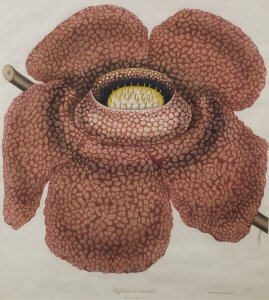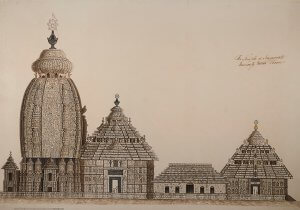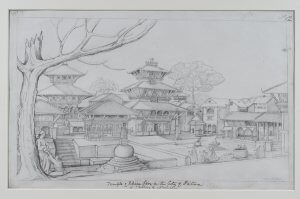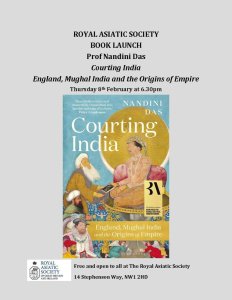Rehanging Artworks at the Society
Over the last couple of weeks, there have been changes taking place on the Society’s premises. Many artworks were removed from the walls for redecoration. But now some of these, and some fresh works, have been hung, alongside panels created for the Extraordinary Endeavours Exhibition of photographs and art too fragile to be displayed. So, if you visit, look out for the changes…
The image at the head of this blogpost shows the corridor as you enter the building where three paintings from our art collection are on display. Above the signing-in table is the engraving of Flower of Rafflesia Arnoldi, a species of plant native to Indonesia and Malaysia noted for producing the largest individual flower in the world. And though the engraving measures 80.5 x 66.2 cm, this may not be a full-size example – the flowers can grow to one metre in diameter and weigh up to 11 kg. The flowers emerge from a large cabbage-looking maroon or dark brown bud. The plant itself is parasitic and though a vascular plant, it lacks any observable leaves, stems or even roots, and does not have chlorophyll, It lives on the vines of the genus, Tetrastigma. In a similar manner to fungi, individual plants grow as a mass of thread-like strands which embed within the host cells and extract the required nutrients and water. It only is seen outside the host plant when it flowers, when it can also be smelt – the aroma produced is of decaying flesh!

The plant was named after Sir Stamford Raffles and Joseph Arnold. One of the first examples known to European botanists was collected by Arnold, a surgeon, on an expedition in 1818 commissioned by Raffles when he was lieutenant-governor of Bencoolen. This particular engraving and the original painting were undertaken by Edward Smith Weddell (1796-1858), one of a significant family firm of early nineteenth-century botanical engravers. It was donated to the Society by Sir Stamford Raffles on 18 March 1826.
Next to this engraving is a pen-and-ink and wash work of the elevation of the temple at Jagannath, Puri, Odisha. This was undertaken by an Indian artist in 1829. This temple is dedicated to the Hindu god, Jagannath, a form of Vishnu. The present temple was rebuilt from the tenth century onwards but on a site of pre-existing temples. The temple complex, of at least 120 temples and shrines, covers more than 37000 square metres and is surrounded by a 6 metre-high wall. The temple tower is built on a raised stone platform and reaches a height of 65 metres; the surrounding pyramidal roofs of the temples and mandapas rise in steps towards the tower.

Our artwork only shows a portion of the temple but shows some of the ornate decoration. It was donated to the Society by Major-General Thomas Hardwicke (1756-1835) in 1829, along with with a plan of the temple and an elevation of the Black Pagoda at Konark, Odisha, all three being executed in pen-and-ink with wash. Hardwicke was a soldier and a naturalist who was in India from 1777 to 1823. He collected many specimens of natural history which were then painted by Indian artists. So, it is perhaps surprising that he donated architectural pictures and not botanical ones.
The final artwork on that side of the corridor shows the temple of Bhimsen, Patan, Napal. This is one of 50 drawings of Nepalese architecture undertaken by Raj Man Singh in 1844 commissioned by Brian Houghton Hodgson. It is a pencil drawing measuring 27.1 x 45.4 cm. Raj Man Singh was born in Kathmandu to a family of hereditary artists and so learnt to paint paubha painting and religious art. But he adapted to make watercolour paintings of birds and mammals for Hodgson alongside these architectural drawings.

Raj Man Singh is recognised as a significant artist. On 31 December 2012, the Postal Services Department of the government of Nepal issued two commemorative postage stamps showing a portrait of the artist to honour his contribution to the development of 19th century art in Nepal. The stamps also show examples of his watercolour paintings of birds and mammals.
Next Thursday, 8 February, 6.30 pm Professor Nandini Das will launch her book, Courting India: England, Mughal India and the Origins of Empire which tells of Thomas Roe’s four years in India as an ambassador sent by James I to the Mughal Empire from 1616-1620. We look forward to her lecture and welcome all to join us.


